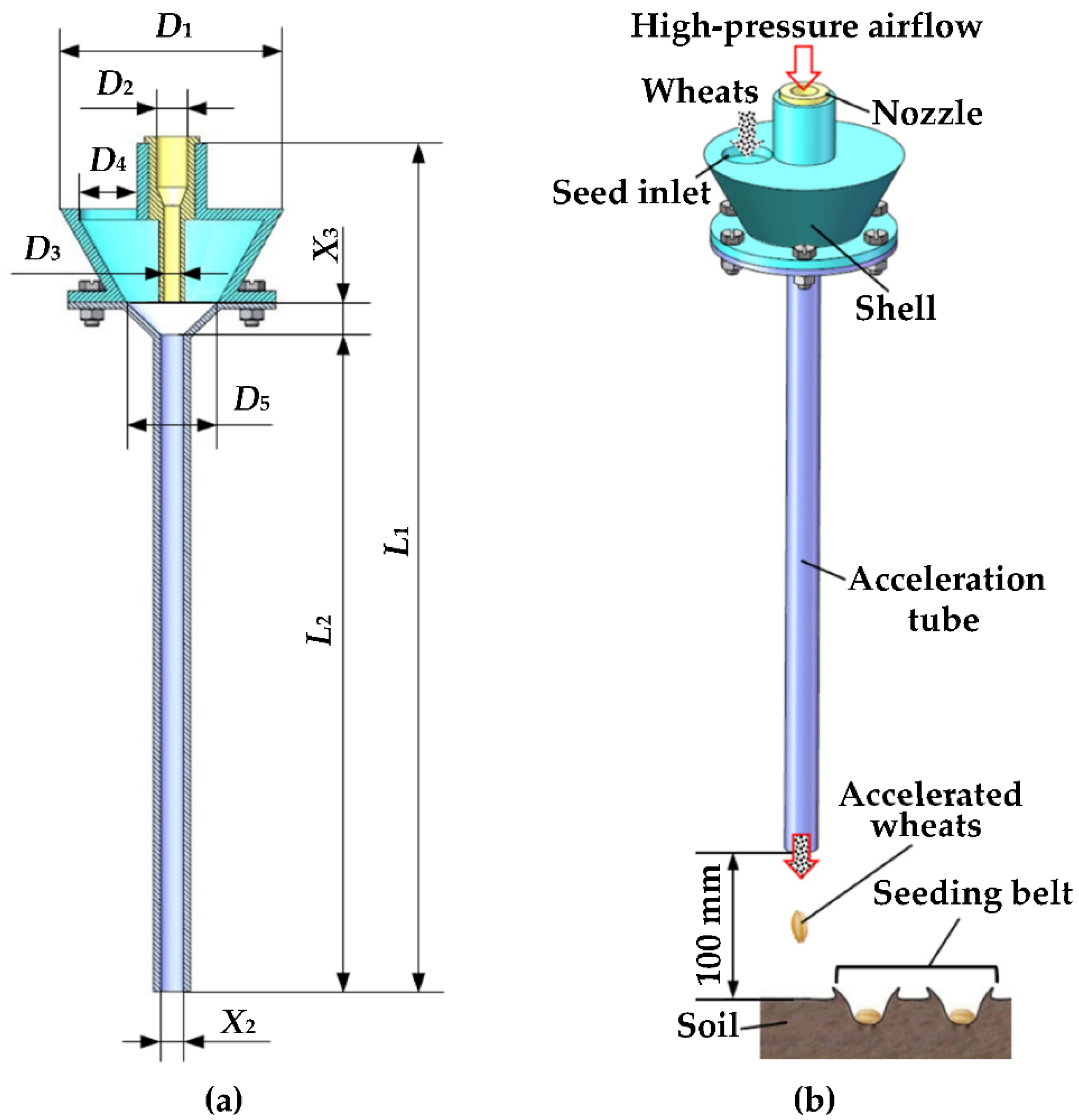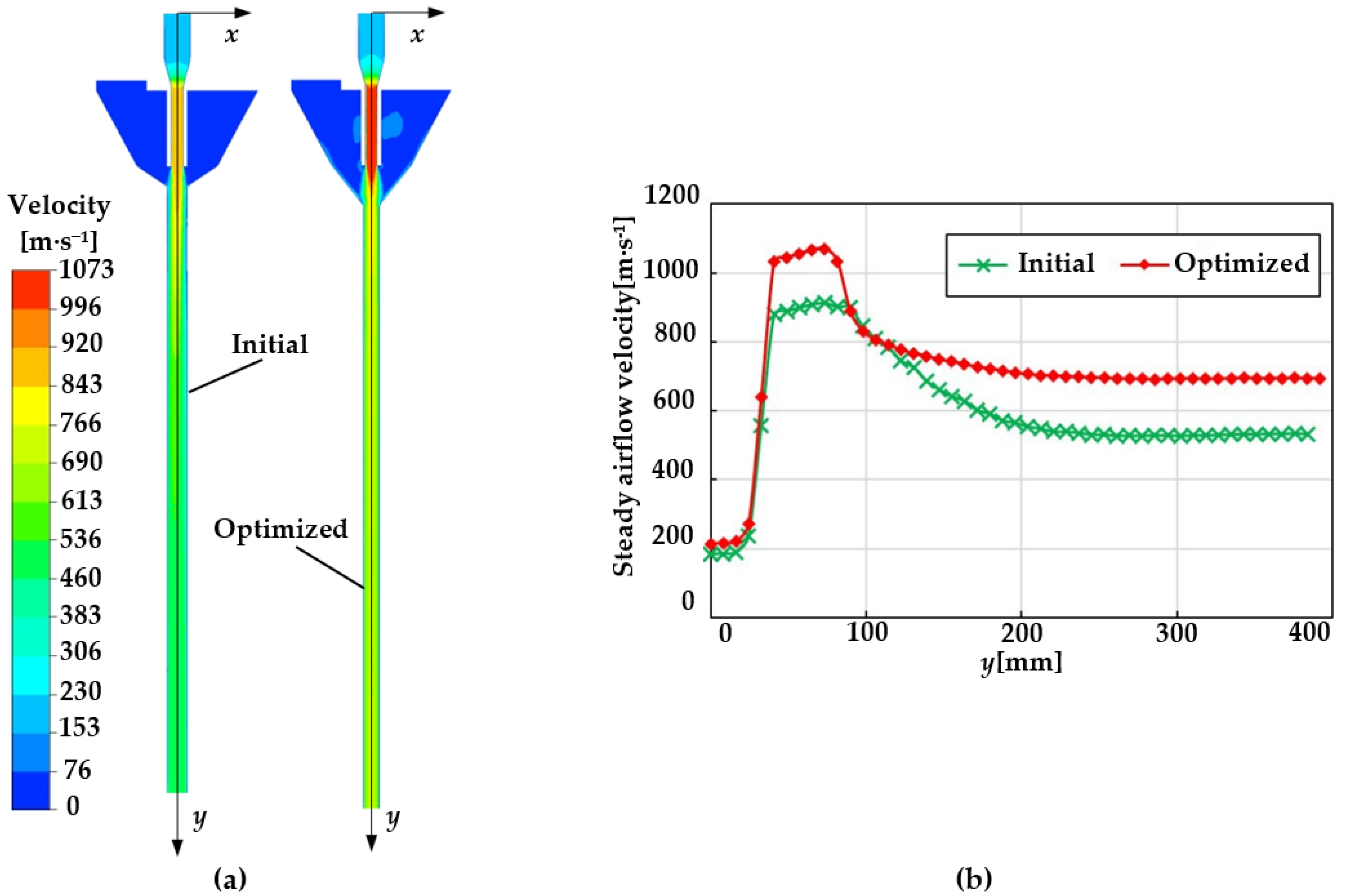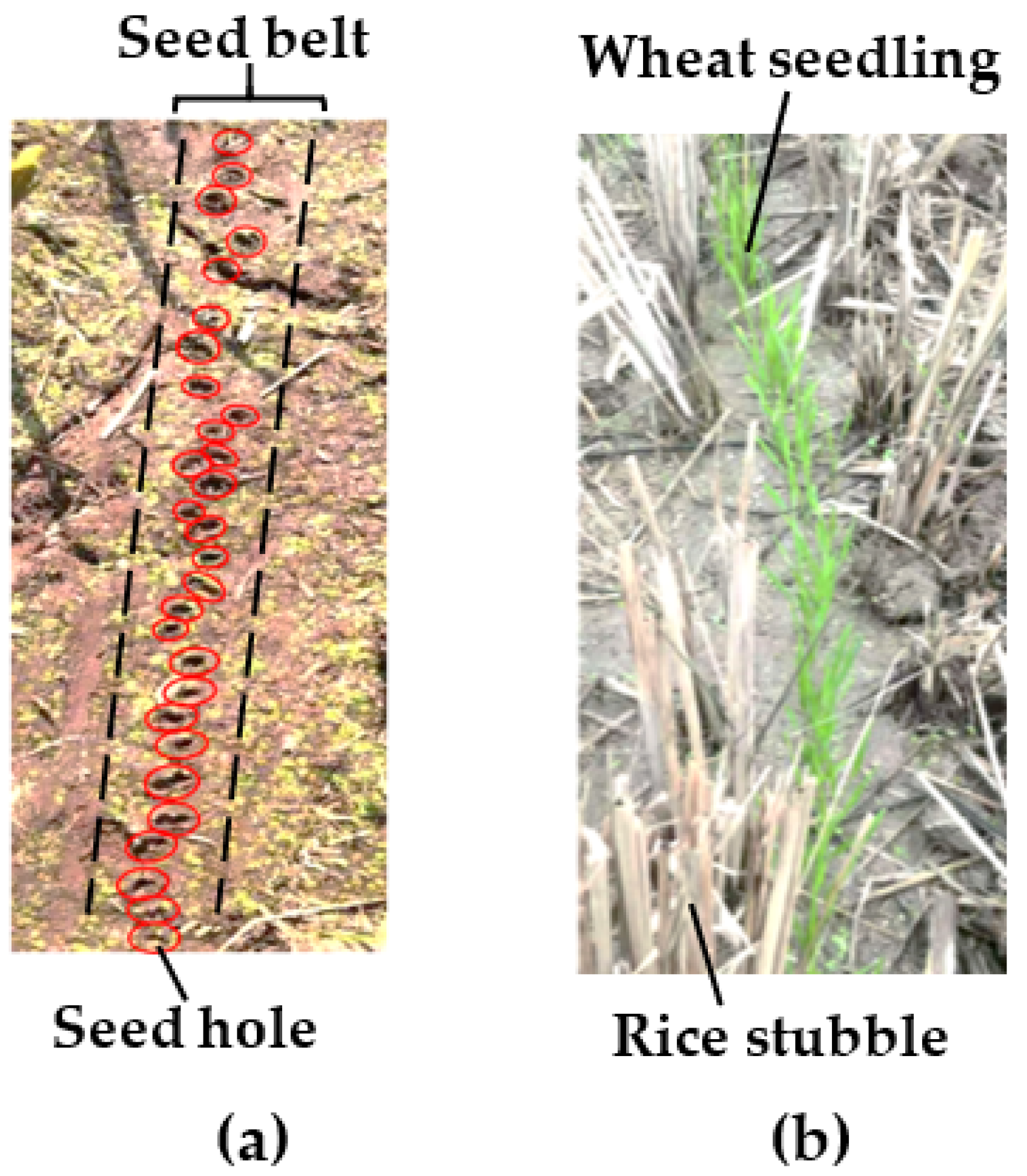Optimization Design of a Pneumatic Wheat-Shooting Device Based on Numerical Simulation and Field Test in Rice–Wheat Rotation Areas
Abstract
:1. Introduction
2. Materials and Methods
2.1. Structure and Working Principle of the PWSD
2.2. Optimization of PWSD Based on Airflow Simulation
2.2.1. Experimental Design
2.2.2. Construction of Simulation Model
Grid Model
Computational Model
3. Results and Analysis
3.1. Regression Model Construction
3.2. Influences of the Interactive Factors on Indexes
4. Optimization and Verification
4.1. Optimization
4.2. Simulation Comparison
4.3. Field-Test Verification
4.3.1. Test Method
Field Seeding Depth
Emergence Rate
4.3.2. Test Results and Analysis
5. Conclusions
- (1)
- In this paper, the optimization of a PWSD was performed. There was a positive correlation between wheat velocity and airflow velocity for the pneumatic shooting process, and shooting depth was related to wheat velocity and soil properties. The shooting depth showed a positive correlation with the wheat velocity under the same soil environment. For the PWSD, the response-surface method and CFD simulation were utilized to maximize SAV and SAL, by which wheat can be sown deeper;
- (2)
- The central airflow velocity of the pneumatic wheat-shooting device showed a sharp increase to a maximum value, then presented a gradual decrease trend, and finally remained relatively constant by simulation analysis. The steady airflow velocity was between the maximum airflow velocity and the high-pressure airflow velocity for each experiment. The higher the high-pressure airflow velocity, the greater was the maximum airflow velocity;
- (3)
- Through the response-surface optimization and CFD simulation analysis, the optimal parameter combination of working pressure 686 kPa, acceleration tube diameter 8 mm and throat distance 20 mm was obtained, and the simulation result of SAV and SAL was 718 m·s−1 and 188 mm, respectively. The optimized device had a faster and more stable airflow field than the initial one in general. After optimization, the steady airflow velocity significantly increased by 34.5%, and the SAL increased by 9.1%. The field test showed that the average field seeding depth of the optimized device was about 68% higher than the initial device, and the emergence rate for the optimized device was about 88.7% without obvious reduction, which meets the requirements of Chinese national standards.
Author Contributions
Funding
Institutional Review Board Statement
Data Availability Statement
Acknowledgments
Conflicts of Interest
References
- China National Bureau of Statistics. Available online: https://www.stats.gov.cn/ (accessed on 12 December 2020).
- China Industrial Information Network. Available online: https://www.chyxx.com/industry/ (accessed on 1 December 2020).
- Li, C.S.; Tang, Y.L.; Xie, L.S.; Huang, G.; Zhong, G.X.; Wu, C.; Cheng, S.L. Design and experiment of 2BMFDC-6 half-tillage seeder of wheat after rice. Southwest Chin. J. Agric. Sci. 2011, 24, 789–793. [Google Scholar]
- Sidhu, H.S.; Singh, M.; Humphreys, E.; Sidhu, B.; Dhillon, S.S.; Blackwell, J.; Bector, V.; Sidhu, M.; Singh, S. The happy seeder enables direct drilling of wheat into rice stubble. Aust. J. Exp. Agric. 2007, 47, 844–854. [Google Scholar] [CrossRef] [Green Version]
- Zhang, X.M.; Zhang, J.M.; Xia, J.F.; Zhang, S.; Li, J.B.; Wu, H. Design and experiment on critical component of cultivator for straw returning in paddy field and dry land. Chin. Soc. Agric. Eng. 2015, 31, 10–16. [Google Scholar]
- Tang, Y.L.; Huang, G.; Yuan, L.X. High-benefit cultivation technique of surface seeding and mulching rice straw for wheat after rice. Crops 2000, 3, 22–24. [Google Scholar]
- Diao, P.S.; Du, R.C.; Yang, Z.D.; Yang, S.D. Theoretical research on pneumatic seeding. J. Agric. Mech. 2005, 27, 94–96. [Google Scholar]
- Wang, Y.B.; Li, H.W.; He, J.; Wang, Q.J.; Lu, C.Y.; Liu, P.; Yang, Q.L. Parameters optimization and experiment of mechanical wheat shooting seed-metering device. Chin. Soc. Agric. Eng. 2020, 36, 1–10. [Google Scholar] [CrossRef]
- Wang, Y.B.; Li, H.W.; Wang, Q.J.; He, J.; Lu, C.Y.; Liu, K.H. Design and experiment of wheat mechanical shooting seed-metering device. Chin. Soc. Agric. Eng. 2020, 51, 73–84. [Google Scholar]
- Wang, C.; Li, H.W.; He, J.; Wang, Q.J.; Cheng, X.P.; Wei, Z.C.; Liu, J.X. Effect of incident angle on wheat soil-ripping parameters by pneumatic seeding. Chin. Soc. Agric. Eng. 2019, 35, 32–39. [Google Scholar]
- Singh, R.C.; Singh, G.; Saraswat, D.C. Optimisation of design and operational parameters of a pneumatic seed metering device for planting cottonseeds. Biosyst. Eng. 2005, 92, 429–438. [Google Scholar] [CrossRef]
- Ariafar, K.; Buttsworth, D.; Sharifi, N.; Malpress, R. Ejector primary nozzle steam condensation: Area ratio effects and mixing layer development. Appl. Thermal Eng. 2014, 71, 519–527. [Google Scholar] [CrossRef]
- Chang, J.F.; Dong, Y.P.; Liu, Q.L.; Guo, F.Q.; Zhang, T.H.; Zhang, K.W. Experimental study and numerical simulation on flow field of venturi scrubber purifying biomass gas. Chin. Soc. Agric. Eng. 2012, 28, 186–192. [Google Scholar]
- Zhao, X.X.; Yu, H.L.; Ma, Y.J.; Zhang, J.G.; Sang, Y.Y.; Huo, X.J. Parameter optimization and experiment of negative pressure precision seed-metering device for wheat. Chin. Soc. Agric. Eng. 2017, 33, 11–18. [Google Scholar]
- Liu, J.X.; Wang, Q.J.; Li, H.W.; He, J.; Lu, C.Y.; Wang, C. Numerical Analysis and Experiment on Pneumatic Loss Characteristic of Pinhole-tube Wheat Uniform Seeding Mechanism. Chin. Soc. Agric. Eng. 2020, 51, 29–37. [Google Scholar]
- Cheng, X.P.; Lu, C.Y.; Meng, Z.J.; Yu, J.Y. Design and parameter optimization on wheat precision seed meter with combination of pneumatic and type hole. Chin. Soc. Agric. Eng. 2018, 34, 1–9. [Google Scholar]
- Wang, C.; Lu, C.; Li, H.; He, J.; Cheng, X. Preliminary bench experiment study on working parameters of pneumatic seeding mechanism for wheat in rice-wheat rotation areas. Int. J. Agric. Biol. Eng. 2020, 13, 66–72. [Google Scholar] [CrossRef]
- Hemidi, A.; Henry, F.; Leclaire, S.; Seynhaeve, J.M.; Bartosiewicz, Y. CFD analysis of a supersonic air ejector. part i: Experimental validation of single-phase and two-phase operation. Appl. Thermal Eng. 2009, 29, 1523–1531. [Google Scholar] [CrossRef] [Green Version]
- Xie, J.; Liu, Y.Y.; Wang, J.F. Effects of nozzle structures of air impinging freezer on heat transfer characteristics of steel strip surface. Chin. Soc. Agric. Eng. 2018, 34, 292–298. [Google Scholar]
- Ghalandari, M.; Koohshahi, E.M.; Mohamadian, F.; Shamshirband, S.; Chau, K.W. Numerical simulation of nanofluid flow inside root canal. Eng. Appl. Comput. Fluid Mech. 2019, 13, 254–264. [Google Scholar] [CrossRef]
- Suvarnakuta, N.; Pianthong, K.; Sriveerakul, T.; Seehanam, W. Performance analysis of a two-stage ejector in an ejector refrigeration system using computational fluid dynamics. Eng. Appl. Comput. Fluid Mech. 2020, 14, 669–682. [Google Scholar] [CrossRef]
- Wang, C.; Li, H.W.; He, J.; Wang, Q.J.; Lu, C.Y.; Wang, J.X. Design and experiment of pneumatic wheat precision seed casting device in rice-wheat rotation areas. Chin. Soc. Agric. Eng. 2020, 51, 43–53. [Google Scholar]
- Liu, Y.; Luo, C.; Zong, W.; Huang, X.; Ma, L.; Lian, G. Optimization of Clamping and Conveying Device for Sunflower Oil Combine Harvester Header. Agriculture 2021, 11, 859. [Google Scholar] [CrossRef]
- Jin, C.Q.; Guo, F.Y.; Xu, J.S.; Li, Q.L.; Chen, M.; Li, J.J.; Yin, X. Optimization of working parameters of soybean combine harvester. Chin. Soc. Agric. Eng. 2019, 35, 10–22. [Google Scholar]
- Hu, Y.; Chen, Y.; Wei, W.; Hu, Z.; Li, P. Optimization Design of Spray Cooling Fan Based on CFD Simulation and Field Experiment for Horticultural Crops. Agriculture 2021, 11, 566. [Google Scholar] [CrossRef]
- Kong, F.; Kim, H.D. Analytical and computational studies on the performance of a two-stage ejector-diffuser system. Int. J. Heat Mass Transf. 2015, 85, 71–87. [Google Scholar] [CrossRef]
- Ruangtrakoon, N.; Thongtip, T.; Aphornratana, S.; Sriveerakul, T. CFD simulation on the effect of primary nozzle geometries for a steam ejector in refrigeration cycle. Int. J. Therm. Sci. 2013, 63, 133–145. [Google Scholar] [CrossRef]
- Wang, L.; Yan, J.; Wang, C.; Li, X. Numerical study on optimization of ejector primary nozzle geometries. Int. J. Refrig. 2017, 76, 219–229. [Google Scholar] [CrossRef]
- Pereira, P.R.; Varga, S.; Soares, J.; Oliveira, A.C.; Lopes, A.M.; Almeida, F.G.; Carneiro, J.F. Experimental results with a variable geometry ejector using R600a as working fluid. Int. J. Refrig. 2014, 46, 77–85. [Google Scholar] [CrossRef]
- Hewedy, N.; Hamed, M.H.; Abou-Taleb, F.S.; Ghonim, T.A. Optimal performance and geometry of supersonic ejector. J. Fluids. Eng. 2008, 130, 436–445. [Google Scholar] [CrossRef]
- Wang, C.; Li, H.; Wang, J.; He, J.; Wang, Q.; Lu, C. CFD simulation and optimization of a pneumatic wheat seeding device. IEEE Access 2020, 8, 214007–214018. [Google Scholar] [CrossRef]
- Ruangtrakoon, N.; Aphornratana, S. Development and performance of steam ejector refrigeration system operated in real application in Thailand. Int. J. Refrig. 2014, 48, 142–152. [Google Scholar] [CrossRef]
- Sriveerakul, T.; Aphornratana, S.; Chunnanond, K. Performance prediction of steam ejector using computational fluid dynamic: Part 2. Flow structure of a steam ejector influenced by operating pressure and geometries. Int. J. Therm. Sci. 2007, 46, 823–833. [Google Scholar] [CrossRef]
- Chen, W.X.; Xue, K.K.; Chen, H.Q.; Chong, D.T.; Yan, J.J. Experimental and Numerical Analysis on the Internal Flow of Supersonic Ejector Under Different Working Modes. Heat Transf. Eng. 2018, 39, 700–710. [Google Scholar] [CrossRef]
- Arihant, S.; Abdus, S. Performance analysis of an ejector for flare gas recovery. Geosyst. Eng. 2014, 17, 169–177. [Google Scholar]
- Li, C.; Tang, Y.; Wu, C.; Huang, G. Effect of sowing patterns on growth, development and yield formation of wheat in rice stubble land. Chin. Soc. Agric. Eng. 2012, 28, 36–43. [Google Scholar]
- Singh, A. Evaluation of wheat sowing technologies under paddy residue conditions. Int. J. For. Crop Improv. 2015, 6, 43–48. [Google Scholar] [CrossRef]







| Parameter | Definition | Value (mm) |
|---|---|---|
| D1 | Shell width | 96 |
| D2 | Nozzle inlet diameter | 13 |
| D3 | Nozzle outlet diameter | 6 |
| D4 | Seed inlet diameter | 12.5 |
| D5 | Cone diameter | 40 |
| X2 | Acceleration tube diameter | 10 |
| X3 | Throat length | 10 |
| L1 | Total length | 390 |
| L2 | Acceleration tube length | 300 |
| Levels | Factors | ||
|---|---|---|---|
| X1 (kPa) | X2 (mm) | X3 (mm) | |
| −1 | 300 | 8 | 10 |
| 0 | 500 | 10 | 15 |
| 1 | 700 | 12 | 20 |
| No. | X1 (kPa) | X2 (mm) | X3 (mm) | Response Values | |
|---|---|---|---|---|---|
| Y1 (m·s−1) | Y2 (mm) | ||||
| 1 | 0 | 0 | 0 | 517 | 172 |
| 2 | −1 | 0 | −1 | 416 | 184 |
| 3 | 1 | 1 | 0 | 536 | 149 |
| 4 | 0 | −1 | 1 | 581 | 196 |
| 5 | 0 | −1 | −1 | 583 | 182 |
| 6 | 1 | 0 | −1 | 633 | 173 |
| 7 | −1 | −1 | 0 | 461 | 198 |
| 8 | 0 | 0 | 0 | 516 | 177 |
| 9 | 1 | 0 | 1 | 614 | 162 |
| 10 | 0 | 0 | 0 | 518 | 169 |
| 11 | −1 | 0 | 1 | 394 | 178 |
| 12 | 0 | 1 | −1 | 520 | 176 |
| 13 | −1 | 1 | 0 | 367 | 161 |
| 14 | 0 | 0 | 0 | 533 | 180 |
| 15 | 1 | −1 | 0 | 718 | 183 |
| 16 | 0 | 1 | 1 | 422 | 152 |
| 17 | 0 | 0 | 0 | 524 | 186 |
| Source | Y1 (m·s−1) | Y2 (mm) | ||||||
|---|---|---|---|---|---|---|---|---|
| Sum of Squares | Freedom | F Value | Significant Level p | Sum of Squares | Freedom | F Value | Significant Level p | |
| Model | 1.308 × 105 | 6 | 165.05 | <0.0001 ** | 2655.25 | 6 | 15.41 | 0.0002 ** |
| X1 | 93,096.13 | 1 | 704.71 | <0.0001 ** | 364.50 | 1 | 12.69 | 0.0052 * |
| X2 | 31,000.50 | 1 | 234.66 | <0.0001 ** | 1830.13 | 1 | 63.72 | <0.0001 ** |
| X3 | 2485.13 | 1 | 18.81 | 0.0015 * | 91.13 | 1 | 3.17 | 0.1052 |
| X1X2 | 1936.00 | 1 | 14.65 | 0.0033 * | 2.25 | 1 | 0.078 | 0.7853 |
| X1X3 | 2.25 | 1 | 0.017 | 0.8988 | 6.25 | 1 | 0.22 | 0.6509 |
| X2X3 | 2304.00 | 1 | 17.44 | 0.0019 * | 361.00 | 1 | 12.57 | 0.0053 * |
| Residual | 1321.06 | 10 | 287.22 | 10 | ||||
| Lack of Fit | 1119.86 | 6 | 3.71 | 0.1125 | 108.42 | 6 | 0.40 | 0.8458 |
| Pure Error | 201.20 | 4 | 178.80 | 4 | ||||
| Cor Total | 1.321 × 105 | 16 | 2942.47 | 16 | ||||
| Test Item | Field Seeding Depth (mm) | ||||||
|---|---|---|---|---|---|---|---|
| Initial | Optimized | ||||||
| Range | Average Value | Stability Coefficient | Range | Average Value | Stability Coefficient | ||
| Number of measurement site | 1 | 10.56~12.84 | 12.02 | 93% | 16.24~21.93 | 18.95 | 91% |
| 2 | 10.25~12.68 | 11.71 | 94% | 19.31~23.74 | 21.07 | 94% | |
| 3 | 9.96~12.85 | 11.62 | 92% | 17.74~21.36 | 19.78 | 93% | |
| 4 | 10.83~13.12 | 12.13 | 94% | 18.66~21.59 | 20.11 | 95% | |
| 5 | 10.48~12.93 | 11.73 | 93% | 17.64~22.84 | 19.83 | 91% | |
| Total average value | 11.84 | 19.95 | |||||
Publisher’s Note: MDPI stays neutral with regard to jurisdictional claims in published maps and institutional affiliations. |
© 2022 by the authors. Licensee MDPI, Basel, Switzerland. This article is an open access article distributed under the terms and conditions of the Creative Commons Attribution (CC BY) license (https://creativecommons.org/licenses/by/4.0/).
Share and Cite
Wang, C.; Li, H.; He, J.; Wang, Q.; Lu, C.; Yang, H. Optimization Design of a Pneumatic Wheat-Shooting Device Based on Numerical Simulation and Field Test in Rice–Wheat Rotation Areas. Agriculture 2022, 12, 56. https://doi.org/10.3390/agriculture12010056
Wang C, Li H, He J, Wang Q, Lu C, Yang H. Optimization Design of a Pneumatic Wheat-Shooting Device Based on Numerical Simulation and Field Test in Rice–Wheat Rotation Areas. Agriculture. 2022; 12(1):56. https://doi.org/10.3390/agriculture12010056
Chicago/Turabian StyleWang, Chao, Hongwen Li, Jin He, Qingjie Wang, Caiyun Lu, and Hanyu Yang. 2022. "Optimization Design of a Pneumatic Wheat-Shooting Device Based on Numerical Simulation and Field Test in Rice–Wheat Rotation Areas" Agriculture 12, no. 1: 56. https://doi.org/10.3390/agriculture12010056






